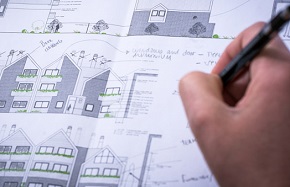Non-material amendment to planning permission
It is sometimes necessary to amend development proposals after planning permission has been granted. Where these are not significant amendments, they may be described as ‘non-material’.
Section 96a of the Town and Country Planning Act 1990, amended by the Planning Act 2008, permits applications for non-material amendment to planning permissions. This avoids the need for a new planning application to be submitted, allowing instead for the existing permission to be amended whilst remaining subject to the original conditions and time limits.
There is no statutory definition for the sort of changes that might be considered non material. Instead it depends on the context, and is determined by the local planning authority. It is advisable therefore to consult with the local planning authority when considering amendments. An application can then be made, and a small fee is payable.
The Town and Country Planning Act suggests that in deciding whether a change is material or not, a local planning authority must have regard to the effect of the change, together with any previous changes made, on the planning permission originally granted.
Where a change is non-material, it is unlikely that public consultation will be necessary, although anyone who may be affected must be informed, and may then make representations to the local authority. The application should be determined within 28 days unless a different time frame has been agreed.
A non-material amendment might be one where:
- It is a very small change.
- It does not vary significantly from what was described on the planning permission.
- It does not conflict with any conditions on the permission.
- It does not breach planning policy.
- It does not significantly move the external envelope outward.
- It does not increase the height of the roof.
- It does not introduce or move windows or other openings that could affect other properties.
A more significant change might be described as a 'minor material amendment'. Again, there is no statutory definition of what this means, however, the Planning Officers Society suggest that a minor material amendment is one ‘…whose scale and nature results in a development which is not substantially different from the one which has been approved.’
This might include an amendment where:
- The site boundary is not changed.
- The siting, landscape, scale and height is not significantly changed.
- The use is not changed.
- The appearance is not adversely affected.
- The change is compliant with local policy and conditions attached to the original permission.
- Changes to windows or other openings that do not impact on neighbouring properties.
- The interests parties consulted about the original application are not disadvantaged.
Such changes might be dealt with by an application to vary a planning condition imposed on the existing permission.
Material changes, for which a fresh application might be required could include:
- Significantly increasing its size.
- Changes to windows or other openings that impact on neighbouring properties.
- Changes that alter the description of development.
- Changes to the application site area.
- Significant alterations to design or the siting of the proposals.
- Changes that would affect objections to the original proposal.
This process does not apply to listed building consents or conservation area consents for which a complete new application must be made.
[edit] Related articles on Designing Buildings Wiki
- Detailed planning application.
- Material alteration.
- Material amendment.
- Material change of use.
- Minor material amendment.
- National Planning Policy Framework.
- National Planning Practice Guidance.
- Outline planning application.
- Permitted development.
- Planning authority.
- Planning conditions.
- Planning consultant.
- Planning enforcement.
- Planning obligations.
- Pre-application advice.
- Section 106 agreement.
[edit] External references
Featured articles and news
RTPI leader to become new CIOB Chief Executive Officer
Dr Victoria Hills MRTPI, FICE to take over after Caroline Gumble’s departure.
Social and affordable housing, a long term plan for delivery
The “Delivering a Decade of Renewal for Social and Affordable Housing” strategy sets out future path.
A change to adoptive architecture
Effects of global weather warming on architectural detailing, material choice and human interaction.
The proposed publicly owned and backed subsidiary of Homes England, to facilitate new homes.
How big is the problem and what can we do to mitigate the effects?
Overheating guidance and tools for building designers
A number of cool guides to help with the heat.
The UK's Modern Industrial Strategy: A 10 year plan
Previous consultation criticism, current key elements and general support with some persisting reservations.
Building Safety Regulator reforms
New roles, new staff and a new fast track service pave the way for a single construction regulator.
Architectural Technologist CPDs and Communications
CIAT CPD… and how you can do it!
Cooling centres and cool spaces
Managing extreme heat in cities by directing the public to places for heat stress relief and water sources.
Winter gardens: A brief history and warm variations
Extending the season with glass in different forms and terms.
Restoring Great Yarmouth's Winter Gardens
Transforming one of the least sustainable constructions imaginable.
Construction Skills Mission Board launch sector drive
Newly formed government and industry collaboration set strategy for recruiting an additional 100,000 construction workers a year.
New Architects Code comes into effect in September 2025
ARB Architects Code of Conduct and Practice available with ongoing consultation regarding guidance.
Welsh Skills Body (Medr) launches ambitious plan
The new skills body brings together funding and regulation of tertiary education and research for the devolved nation.
Paul Gandy FCIOB announced as next CIOB President
Former Tilbury Douglas CEO takes helm.
UK Infrastructure: A 10 Year Strategy. In brief with reactions
With the National Infrastructure and Service Transformation Authority (NISTA).























